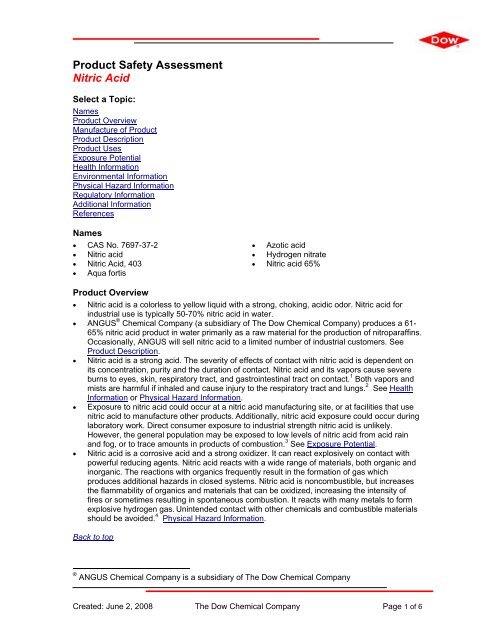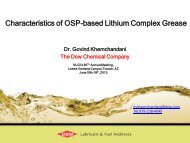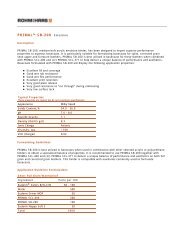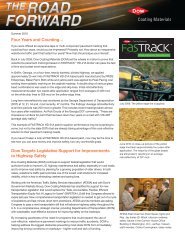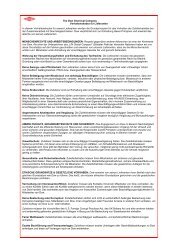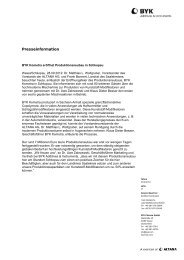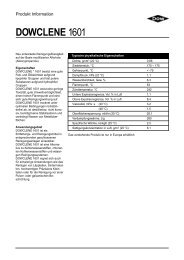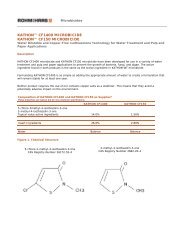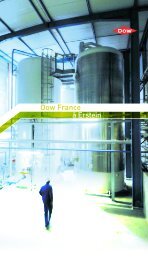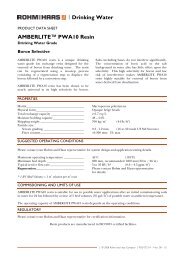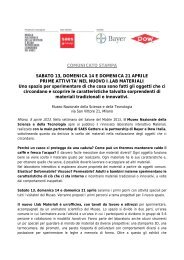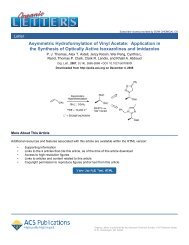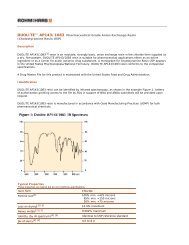Product Safety Assessment Nitric Acid - The Dow Chemical Company
Product Safety Assessment Nitric Acid - The Dow Chemical Company
Product Safety Assessment Nitric Acid - The Dow Chemical Company
You also want an ePaper? Increase the reach of your titles
YUMPU automatically turns print PDFs into web optimized ePapers that Google loves.
<strong>Product</strong> <strong>Safety</strong> <strong>Assessment</strong><br />
<strong>Nitric</strong> <strong>Acid</strong><br />
Select a Topic:<br />
Names<br />
<strong>Product</strong> Overview<br />
Manufacture of <strong>Product</strong><br />
<strong>Product</strong> Description<br />
<strong>Product</strong> Uses<br />
Exposure Potential<br />
Health Information<br />
Environmental Information<br />
Physical Hazard Information<br />
Regulatory Information<br />
Additional Information<br />
References<br />
Names<br />
• CAS No. 7697-37-2 • Azotic acid<br />
• <strong>Nitric</strong> acid • Hydrogen nitrate<br />
• <strong>Nitric</strong> <strong>Acid</strong>, 403 • <strong>Nitric</strong> acid 65%<br />
• Aqua fortis<br />
<strong>Product</strong> Overview<br />
• <strong>Nitric</strong> acid is a colorless to yellow liquid with a strong, choking, acidic odor. <strong>Nitric</strong> acid for<br />
industrial use is typically 50-70% nitric acid in water.<br />
• ANGUS ® <strong>Chemical</strong> <strong>Company</strong> (a subsidiary of <strong>The</strong> <strong>Dow</strong> <strong>Chemical</strong> <strong>Company</strong>) produces a 61-<br />
65% nitric acid product in water primarily as a raw material for the production of nitroparaffins.<br />
Occasionally, ANGUS will sell nitric acid to a limited number of industrial customers. See<br />
<strong>Product</strong> Description.<br />
• <strong>Nitric</strong> acid is a strong acid. <strong>The</strong> severity of effects of contact with nitric acid is dependent on<br />
its concentration, purity and the duration of contact. <strong>Nitric</strong> acid and its vapors cause severe<br />
burns to eyes, skin, respiratory tract, and gastrointestinal tract on contact. 1 Both vapors and<br />
mists are harmful if inhaled and cause injury to the respiratory tract and lungs. 2 See Health<br />
Information or Physical Hazard Information.<br />
• Exposure to nitric acid could occur at a nitric acid manufacturing site, or at facilities that use<br />
nitric acid to manufacture other products. Additionally, nitric acid exposure could occur during<br />
laboratory work. Direct consumer exposure to industrial strength nitric acid is unlikely.<br />
However, the general population may be exposed to low levels of nitric acid from acid rain<br />
and fog, or to trace amounts in products of combustion. 3 See Exposure Potential.<br />
• <strong>Nitric</strong> acid is a corrosive acid and a strong oxidizer. It can react explosively on contact with<br />
powerful reducing agents. <strong>Nitric</strong> acid reacts with a wide range of materials, both organic and<br />
inorganic. <strong>The</strong> reactions with organics frequently result in the formation of gas which<br />
produces additional hazards in closed systems. <strong>Nitric</strong> acid is noncombustible, but increases<br />
the flammability of organics and materials that can be oxidized, increasing the intensity of<br />
fires or sometimes resulting in spontaneous combustion. It reacts with many metals to form<br />
explosive hydrogen gas. Unintended contact with other chemicals and combustible materials<br />
should be avoided. 4 Physical Hazard Information.<br />
Back to top<br />
® ANGUS <strong>Chemical</strong> <strong>Company</strong> is a subsidiary of <strong>The</strong> <strong>Dow</strong> <strong>Chemical</strong> <strong>Company</strong><br />
Created: June 2, 2008 <strong>The</strong> <strong>Dow</strong> <strong>Chemical</strong> <strong>Company</strong> Page 1 of 6
<strong>Product</strong> <strong>Safety</strong> <strong>Assessment</strong>: <strong>Nitric</strong> <strong>Acid</strong><br />
Manufacture of <strong>Product</strong><br />
• Capacity – ANGUS <strong>Chemical</strong> <strong>Company</strong> (ANGUS) has manufactured products from<br />
nitroalkanes and their derivatives for more than 70 years. 5 Global nitric acid production in<br />
2006 was estimated at about 51 million metric tons or 112.4 billion pounds. 6<br />
• Process – <strong>Nitric</strong> acid is manufactured by the oxidation of ammonia by air or oxygen using a<br />
multi-step process with a catalyst based on the Ostwald 7 reaction.<br />
Back to top<br />
<strong>Product</strong> Description 8<br />
<strong>Nitric</strong> acid is a colorless to yellow liquid with a characteristic strong, choking, acidic odor. It is one<br />
of the most common strong acids and is a strong oxidizing agent. It is completely soluble in water.<br />
<strong>Nitric</strong> acid may be sold in a variety of different concentrations in water. <strong>Nitric</strong> acid for industrial<br />
use is typically 50-70% nitric acid in water. ANGUS produces a 61-65% nitric acid product in<br />
water primarily as a raw material for the production of nitroparaffins. ANGUS will occasionally sell<br />
nitric acid to a limited number of industrial customers.<br />
Fuming nitric acid is a concentrated nitric acid containing nitrogen oxide and typically contains<br />
more than 85% nitric acid (white fuming nitric acid contains more than 97.5% and red fuming<br />
nitric acid contains more than 85%). Nitrogen dioxide and nitrogen oxide gases are emitted from<br />
concentrated nitric acid 85-100% concentrations). 9 ANGUS does not produce or sell fuming<br />
nitric acid.<br />
Back to top<br />
<strong>Product</strong> Uses 10,11<br />
<strong>Nitric</strong> acid sold commercially is primarily used as a chemical intermediate in the synthesis of<br />
fertilizers, dyes and pharmaceuticals. It is also used in metallurgy, photoengraving, etching steel,<br />
metal ore flotation, laboratory work, and the production of urethane and rubber chemicals.<br />
Ammonium nitrite production accounts for 75% of the world nitric acid market. Two-thirds of the<br />
ammonium nitrate produced globally is used for fertilizer production while the remaining one-third<br />
is used for industrial applications. Other non-ammonium nitrate products are produced from nitric<br />
acid, including: adipic acid, nitrobenzene, and toluene diisocyanate.<br />
Overall it is estimated that the fertilizer industry accounts for 55-60% of the global nitric acid<br />
market. Likewise, the majority of nitric acid produced in the United States is sold into the<br />
manufacture of ammonium nitrate fertilizer, accounting for consumption of 75% of the 6 million<br />
tons produced annually in the U.S.<br />
ANGUS uses the vast majority of the nitric acid it produces as a raw material for its production of<br />
nitroparaffins.<br />
Back to top<br />
Exposure Potential<br />
Based on the uses for nitric acid, the public could be exposed through:<br />
• Workplace exposure – Exposure can occur either in a nitric acid manufacturing facility or in<br />
educational, industrial or manufacturing facilities that use nitric acid as a laboratory chemical<br />
or as an intermediate. Those working with nitric acid in manufacturing operations could be<br />
exposed to liquid or vapor during maintenance, transfer, sampling, testing, disposal, or other<br />
procedures. Each manufacturing facility should maintain adequate ventilation and use<br />
engineering controls to maintain airborne levels below the relevant workplace exposure limits.<br />
Also employers should provide thorough employee training, appropriate work processes, and<br />
safety equipment to prevent exposure. See Health Information.<br />
Created: June 2, 2008 <strong>The</strong> <strong>Dow</strong> <strong>Chemical</strong> <strong>Company</strong> Page 2 of 6
<strong>Product</strong> <strong>Safety</strong> <strong>Assessment</strong>: <strong>Nitric</strong> <strong>Acid</strong><br />
• Consumer exposure to products containing nitric acid – ANGUS does not sell nitric acid<br />
for consumer use and products containing high concentrations of nitric acid are not typically<br />
used by consumers. However, the general public may be exposed to trace amounts of nitric<br />
acid in acid rain and fog, or from products of combustion. See Health Information.<br />
• Environmental releases 12 – In the event of a small spill, the focus is on containing the spill<br />
to prevent contamination of soil, and surface or ground water. Evacuate the area. Personnel<br />
wearing full protective clothing should then isolate and contain the spill with dikes. DO NOT<br />
USE ABSORBENT MATERIALS such as: wood chips, sawdust, and cellulose-based, organic<br />
or polymeric absorbents. Carefully neutralize remaining acid on the ground with soda ash or<br />
other neutralizing materials. <strong>The</strong> reaction with soda ash or any other carbonate will release<br />
CO2 gas and heat. Addition of water will also generate heat. Collect material in suitable and<br />
properly labeled containers. Flush the contaminated area with water. See Environmental,<br />
Health and Physical Hazard Information.<br />
• Large release 13 – Industrial spills or releases are infrequent, and are generally contained. If a<br />
large spill does occur, evacuate personnel upwind and ventilate the area. Collect leaking and<br />
spilled liquid in appropriate sealable containers as completely as possible. Cautiously<br />
neutralize the remainder of the spilled material with soda ash powder or other neutralizing<br />
material. Only trained and properly protected personnel should be involved in clean-up<br />
operations. Keep out of sewers and other waterways.<br />
• In case of fire, properly protected and trained fire fighting personnel should extinguish the<br />
fire with water, fog or fine spray. Adding water to nitric acid will generate heat, fumes, and<br />
may cause splattering, so use water cautiously. <strong>Nitric</strong> acid does not burn; if exposed to fire<br />
from another source, suitable extinguishing agent should be selected for that fire. Dry<br />
chemical extinguishing agents may react with product so must only be used with caution.<br />
Follow emergency procedures carefully. See Environmental, Health and Physical Hazard<br />
Information.<br />
For more information, see the relevant <strong>Safety</strong> Data Sheet.<br />
Back to top<br />
Health Information 14,15<br />
<strong>The</strong> effects of exposure to nitric acid depend upon the airborne or in-solution concentration and<br />
the duration of contact. Exposure effects can range from mild to severe, even producing death.<br />
Ingestion of nitric acid is considered to be toxic. One teaspoon or 6 milliliters (0.2 ounces) of this<br />
material is corrosive to mucous membranes and/or fatal.<br />
Inhalation of excessive nitric acid mist or vapor prompts coughing, gagging, chest pain, and<br />
difficulty breathing. In sufficiently high concentrations, a single, relatively short inhalation<br />
exposure can cause injury with fluid in the lungs. Symptoms may be delayed. Chronic exposure<br />
to lower concentrations of vapors can lead to bronchitis and chemical pneumonia. <strong>The</strong> vapor and<br />
mists of nitric acid may also cause erosion of teeth.<br />
On the skin, nitric acid can produce severe penetrating burns, ulceration, yellow discoloration and<br />
corrosion. <strong>Nitric</strong> acid also causes severe irritation to eyes upon contact, and may result in<br />
permanent injury to eyes. <strong>Nitric</strong> acid vapor may also cause eye irritation with pain and redness.<br />
For more information, see the <strong>Safety</strong> Data Sheet.<br />
Back to top<br />
Environmental Information 16<br />
<strong>Nitric</strong> acid is slightly toxic to aquatic organisms based on ecotoxicity testing. <strong>Nitric</strong> acid may<br />
decrease the pH of aquatic systems to less than pH 5 which may be toxic to aquatic species. <strong>The</strong><br />
Created: June 2, 2008 <strong>The</strong> <strong>Dow</strong> <strong>Chemical</strong> <strong>Company</strong> Page 3 of 6
<strong>Product</strong> <strong>Safety</strong> <strong>Assessment</strong>: <strong>Nitric</strong> <strong>Acid</strong><br />
bioconcentration potential of nitric acid is low and its potential for mobility in soil is very high. <strong>Nitric</strong><br />
acid will not biodegrade readily in the environment, but will ionize in water and be readily<br />
neutralized by the natural buffering capacity (alkalinity) present in the soil and surface water. <strong>The</strong><br />
nitrate ion will ultimately become an inorganic nutrient for plant species.<br />
For more information, see the <strong>Safety</strong> Data Sheet.<br />
Back to top<br />
Physical Hazard Information 17<br />
<strong>Nitric</strong> acid is a strong oxidizer, even when fairly dilute and at ambient temperatures. It can react<br />
explosively on contact with powerful reducing agents. While nitric acid is noncombustible, it<br />
increases the flammability of organic and readily oxidizable materials in fire situations. <strong>Nitric</strong> acid<br />
also reacts with many metals to form explosive hydrogen gas.<br />
<strong>Nitric</strong> acid reacts explosively with all metallic powders, carbides, hydrogen sulfide, and turpentine<br />
or other organics.<br />
<strong>Nitric</strong> acid reacts violently with many common organic solvents and chemicals, such as ethanol,<br />
turpentine, bases, most metals, and many other materials. <strong>The</strong> reactions with organics frequently<br />
result in the formation of gas which produces additional hazards in closed systems. Contact with<br />
combustible materials such as wood chips, sawdust, cellulose and polymeric absorbents can<br />
cause a fire. Water added to nitric acid will generate heat, fumes, and splattering. If it is<br />
necessary to mix with water, nitric acid should be added slowly while stirring.<br />
Store in a location where potential spills can be contained and in a location away from<br />
combustible or incompatible materials.<br />
For more information, see the <strong>Safety</strong> Data Sheet.<br />
Back to top<br />
Regulatory Information<br />
Regulations may exist that govern the manufacture, sale, transportation, use and/or disposal of<br />
nitric acid. <strong>The</strong>se regulations may vary by city, state, country or geographic region. Information<br />
may be found by consulting the relevant <strong>Safety</strong> Data Sheet or Contact Us.<br />
Back to top<br />
Additional Information<br />
• <strong>Safety</strong> Data Sheet (http://www.dow.com/webapps/msds/msdssearch.aspx)<br />
• World Health Organization (WHO) <strong>Chemical</strong> Cards, International Program on <strong>Chemical</strong><br />
<strong>Safety</strong> (IPCS) – <strong>Nitric</strong> acid, search CAS=7697-37-2<br />
(http://www.ilo.org/public/english/protection/safework/cis/products/icsc/dtasht/_icsc01/icsc018<br />
3.htm)<br />
• European <strong>Chemical</strong> Substances Information System (ESIS) for CAS=7697-37-2, and IUCLID<br />
<strong>Chemical</strong> Data Sheet (containing specific study data)<br />
(http://ecb.jrc.it/esis/)<br />
• WWW Scorecard <strong>Nitric</strong> acid Information – <strong>Nitric</strong> acid, search CAS=7697-37-2<br />
(http://www.scorecard.org/chemical-profiles/summary.tcl?edf_substance_id=7697-37-2)<br />
• NIOSH Pocket Guide to <strong>Chemical</strong> Hazards – <strong>Nitric</strong> acid, search CAS=7697-37-2<br />
(http://www.cdc.gov/niosh/npg/npgd0447.html)<br />
• CalEPA Air Resources Board Toxic Air Contaminant Summary, <strong>Nitric</strong> <strong>Acid</strong> <strong>Chemical</strong> Profile<br />
(http://www.scorecard.org/chemical-profiles/html/nitric_acid.html)<br />
Created: June 2, 2008 <strong>The</strong> <strong>Dow</strong> <strong>Chemical</strong> <strong>Company</strong> Page 4 of 6
<strong>Product</strong> <strong>Safety</strong> <strong>Assessment</strong>: <strong>Nitric</strong> <strong>Acid</strong><br />
• EPA AEGLS for <strong>Nitric</strong> <strong>Acid</strong><br />
(http://www.epa.gov/oppt/aegl/pubs/tsd310.pdf)<br />
• OSHA <strong>Chemical</strong> Sampling Information, for <strong>Nitric</strong> <strong>Acid</strong><br />
(http://www.osha.gov/dts/chemicalsampling/data/CH_256600.html)<br />
• NIOSH Criteria Document for <strong>Nitric</strong> <strong>Acid</strong> entitled, “Criteria for a recommended standard…<br />
Occupational Exposure to <strong>Nitric</strong> <strong>Acid</strong>,” National Institute for Occupational <strong>Safety</strong> and Health<br />
(NIOSH), HEW Publication No. (NIOSH) 76-141 GPO NO. 017-033-00169-3, U.S.<br />
Government Printing Office, Washington, D.C., March 1976<br />
• Occupational Health Guideline for <strong>Nitric</strong> <strong>Acid</strong>, U.S. Department of Labor Occupational <strong>Safety</strong><br />
and Health Administration (OSHA), September, 1978<br />
• American Conference of Governmental Industrial Hygienists, “<strong>Nitric</strong> <strong>Acid</strong>”,<br />
Documentation of the Threshold Limit Values for Substances in Workroom Air (6 th edition),<br />
Cincinnati<br />
• OSHA/EPA Occupational <strong>Chemical</strong> Database Website, <strong>Nitric</strong> acid, search<br />
CAS=7697-37-2 (US OSHA and EPA database of information on more than 800 chemicals<br />
commonly found in the workplace<br />
(http://www.osha.gov/web/dep/chemicaldata/#target)<br />
• Hazardous Substances Data Bank by the National Library of Medicine, <strong>Nitric</strong> acid, search<br />
CAS=7697-37-2<br />
(http://toxnet.nlm.nih.gov/)<br />
For more business information about nitric acid, visit the ANGUS web site: www.dow.com/angus.<br />
Back to top<br />
References<br />
1 American Conference of Governmental Industrial Hygienists (ACGIH), “<strong>Nitric</strong> <strong>Acid</strong>,”<br />
Documentation of the Threshold Limit Values for Substances in Workroom Air (6 th ed.),<br />
Cincinnati, 2001, pages 1-2.<br />
2 <strong>Nitric</strong> <strong>Acid</strong> Material <strong>Safety</strong> Data Sheet, ANGUS <strong>Chemical</strong> <strong>Company</strong>, Identification Number: 62496<br />
/ 1031, January 28, 2008, pages 1-2.<br />
3 National Advisory Committee for Acute Exposure Guideline Levels for Hazardous Substances<br />
(NAC/AEGL Committee), “Acute Exposure Guideline Levels (AEGLs) for <strong>Nitric</strong> <strong>Acid</strong> (CAS Reg.<br />
No. 7697-37-2) – Interim 1,” October 2006, page 6.<br />
4 <strong>Nitric</strong> <strong>Acid</strong> Material <strong>Safety</strong> Data Sheet, ANGUS <strong>Chemical</strong> <strong>Company</strong>, Identification Number: 62496<br />
/ 1031, January 28, 2008, page 5.<br />
5 <strong>Dow</strong>/ANGUS website: About Us (http://www.dow.com/angus/about/)<br />
6 CEH Marketing Research Report: <strong>Nitric</strong> <strong>Acid</strong>, <strong>Chemical</strong> Economics Handbook, SRI Consulting,<br />
September 2007, Abstract.<br />
7 <strong>Chemical</strong> <strong>The</strong>saurus Reaction <strong>Chemical</strong> Database: Ostwald Process for the Manufacture of<br />
<strong>Nitric</strong> <strong>Acid</strong>, (http://www.chemthes.com/rxn_dp.php?id=2335).<br />
8 ACGIH, “<strong>Nitric</strong> <strong>Acid</strong>,” Documentation of the Threshold Limit Values for Substances in Workroom<br />
Air (6 th ed.), Cincinnati, 2001, page 1.<br />
9 ACGIH, “<strong>Nitric</strong> <strong>Acid</strong>,” Documentation of the Threshold Limit Values for Substances in<br />
Workroom Air (6 th ed.), Cincinnati, 2001, page 1.<br />
10 ACGIH, “<strong>Nitric</strong> <strong>Acid</strong>,” Documentation of the Threshold Limit Values for Substances in<br />
Workroom Air (6 th ed.), Cincinnati, 2001, page 1.<br />
11 CEH Marketing Research Report: <strong>Nitric</strong> <strong>Acid</strong>, <strong>Chemical</strong> Economics Handbook, SRI Consulting,<br />
September 2007, page 7.<br />
12 <strong>Nitric</strong> <strong>Acid</strong> Material <strong>Safety</strong> Data Sheet, ANGUS <strong>Chemical</strong> <strong>Company</strong>, Identification Number:<br />
62496 / 1031, January 28, 2008, pages 3-5.<br />
13 <strong>Nitric</strong> <strong>Acid</strong> Material <strong>Safety</strong> Data Sheet, ANGUS <strong>Chemical</strong> <strong>Company</strong>, Identification Number:<br />
62496 / 1031, January 28, 2008, pages 3-5.<br />
14 ACGIH, “<strong>Nitric</strong> <strong>Acid</strong>,” Documentation of the Threshold Limit Values for Substances in<br />
Workroom Air (6 th ed.), Cincinnati, 2001, page 1.<br />
Created: June 2, 2008 <strong>The</strong> <strong>Dow</strong> <strong>Chemical</strong> <strong>Company</strong> Page 5 of 6
<strong>Product</strong> <strong>Safety</strong> <strong>Assessment</strong>: <strong>Nitric</strong> <strong>Acid</strong><br />
15<br />
<strong>Nitric</strong> <strong>Acid</strong> Material <strong>Safety</strong> Data Sheet, ANGUS <strong>Chemical</strong> <strong>Company</strong>, Identification Number:<br />
62496 / 1031, January 28, 2008, pages 1-2.<br />
16<br />
<strong>Nitric</strong> <strong>Acid</strong> Material <strong>Safety</strong> Data Sheet, ANGUS <strong>Chemical</strong> <strong>Company</strong>, Identification Number:<br />
62496 / 1031, January 28, 2008, page 6.<br />
17<br />
<strong>Nitric</strong> <strong>Acid</strong> Material <strong>Safety</strong> Data Sheet, ANGUS <strong>Chemical</strong> <strong>Company</strong>, Identification Number:<br />
62496 / 1031, January 28, 2008, pages 3-5.<br />
Back to top<br />
NOTICES:<br />
As part of its 2015 Sustainability Goals, <strong>Dow</strong> has committed to make publicly available safety<br />
assessments for its products globally. This product safety assessment is intended to give general<br />
information about the chemical (or categories of chemicals) addressed. It is not intended to<br />
provide an in-depth discussion of health and safety information. Additional information is available<br />
through the relevant <strong>Safety</strong> Data Sheet, which should be consulted before use of the chemical.<br />
This product safety assessment does not replace required communication documents such as<br />
the <strong>Safety</strong> Data Sheet.<br />
<strong>The</strong> information herein is supplied upon the condition that the persons receiving same will make<br />
their own determination as to its suitability for their purposes prior to use. In no event will <strong>Dow</strong> be<br />
responsible for damages of any nature whatsoever resulting from the use of or reliance upon the<br />
information herein or the product to which that information refers.<br />
Nothing contained herein is to be construed as a recommendation to use any product, process,<br />
equipment or formulation in conflict with any patent, and <strong>Dow</strong> makes no representation or<br />
warranty, express or implied, that the use thereof will not infringe any patent.<br />
NO REPRESENTATIONS OR WARRANTIES, EITHER EXPRESS OR IMPLIED, OF<br />
MERCHANTABILITY, FITNESS FOR A PARTICULAR PURPOSE OR OF ANY OTHER<br />
NATURE ARE MADE HEREUNDER WITH RESPECT TO INFORMATION OR THE PRODUCT<br />
TO WHICH INFORMATION REFERS.<br />
<strong>Dow</strong> makes no commitment to update or correct any information that appears on the Internet or<br />
on its World-Wide Web server. <strong>The</strong> information contained in this document is supplemental to the<br />
Internet Disclaimer, http://www.dow.com/homepage/disclosure.html<br />
Back to top<br />
Form No. 233-00312-0608<br />
Created: June 2, 2008 <strong>The</strong> <strong>Dow</strong> <strong>Chemical</strong> <strong>Company</strong> Page 6 of 6


